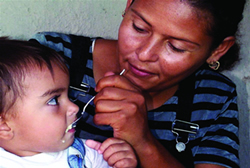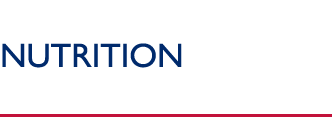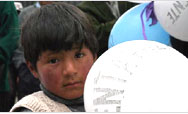Maternal, Infant, and Young Child Nutrition
|
 |
| |
A child in Latin America receiving complementary foods.
Source: The Manoff Group |
Infant and young child feeding is a continuum of critical nutrition and health practices that begin during pregnancy and continue through at least the first two years of life. The sharpest increase in malnutrition occurs between 6 and 24 months of age, the time when children grow most rapidly. USAID works with countries to deliver a package of key infant and child feeding interventions to prevent malnutrition, including:
Optimal maternal nutrition practices: A chance for a healthy life begins during pregnancy and lactation, when children depend on their mothers to get essential energy, protein, fats, and micronutrients. USAID supports mothers to increase the quality, quantity, and diversity of their diets and promote the use of micronutrient supplements, when needed, during pregnancy and lactation.
Optimal breastfeeding practices: One of the best ways to prevent the consequences of malnutrition is to ensure mothers understand and are empowered to follow optimal breastfeeding practices. Breastmilk is the perfect food for babies. It has all of the nutrients and antibodies that a baby needs to thrive during the first six months of life. In addition, it is safe, hygienic, and readily available at no cost. That’s why mothers should breastfeed exclusively during this time — without adding any other foods or liquids, including water, to their infants’ diet.
USAID recommends that mothers initiate breastfeeding within one hour of childbirth so that their infants receive critical nutrients and protection against infection during the first three days of life. The mother should continue to practice frequent, on-demand, and exclusive breastfeeding for the first six months, and continue to breastfeed, along with adding complementary foods, for up to two years. Mothers should practice skin-to-skin contact when breastfeeding their infants to help with temperature regulation.
Optimal complementary feeding practices: From 6 months onward, children need complementary foods in addition to breastmilk. The introduction of appropriate complementary foods is needed at 6 months to ensure children continue to grow and thrive. However, in many countries children either receive food too early or too late. In USAID-supported programs, mothers are encouraged to give their children the appropriate amounts of high-quality, hygienically prepared complementary foods to meet their children’s nutritional needs. In places where traditional complementary foods lack some or all of the energy and nutrients young children require, USAID supports programs that use innovative products like micronutrient powders or lipid-based nutrient supplements to prevent malnutrition during this critical time frame.
Improved infant feeding during and after illness: Children’s food and fluid needs increase when they are ill — a time when they are often anorexic. Although many children decrease their food intake during illness, research has shown that they should continue to breastfeed to help prevent dehydration and malnutrition and assist in recovery. Infants and children need additional foods after an illness for catch-up growth.
Safe feeding practices for infants affected by HIV/AIDS: Children with HIV-positive mothers have special nutritional needs. USAID provides nutritional guidance based on international recommendations from the World Health Organization’s 2006 Consensus Statement on HIV and Infant Feeding to ensure safe and optimal infant feeding practices and to increase HIV-free survival for infants and young children. USAID supports HIV-positive mothers in making the most appropriate decisions about feeding their children.
Related Links
|


